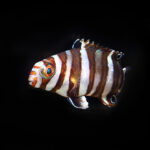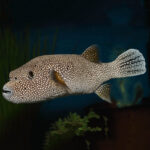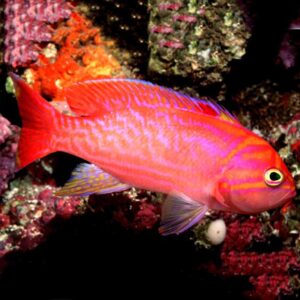Description
The Hi-Hat Sweetlips, scientifically known as Equetus acuminatus, is an intriguing fish species with a distinctive appearance. It can reach a maximum size of around 16 inches (40 centimetres) in length. The body of the Hi-Hat Sweetlips is an ungainly shape. They have large fins, a relatively small head compared to the body, and a pointed snout. It is adorned in horizontal black and white bands.
Taxonomy
Belonging to the genus Equetus, the Hi-Hat Sweetlips is a member of the family Haemulidae, commonly known as the grunt or sweetlips family. This family comprises various species of marine fishes characterized by their strong, grinding teeth. The Hi-Hat Sweetlips is closely related to other members of the Equetus genus, such as Equetus lanceolatus and Equetus punctatus. The genus name “Equetus” is derived from the Latin word meaning “horse,” alluding to the horse-like appearance of these fish.
Natural Habitat
The Hi-Hat Sweetlips can be found in a variety of marine habitats, including coral reefs, rocky areas, and seagrass beds. Its natural habitat is characterized by clear, warm waters with moderate to strong water currents. These fish often inhabit areas with abundant hiding spots, such as caves, crevices, and coral heads. The reef environment provides them with ample food sources, including small invertebrates and small fish.
Keeping Hi-Hat Sweetlips Healthy:
The care level for Hi-Hat Sweetlips is moderate, requiring some experience and attention to ensure their well-being. Maintaining suitable water conditions is crucial, including a temperature range of 75-82°F (24-28°C) and a pH level between 8.1 and 8.4. Regular monitoring of water quality parameters, such as ammonia and nitrate levels, is essential to maintain a healthy aquarium environment. A tank size of at least 100 gallons (380 litres) is recommended to provide ample space for the fish to swim.
Special Requirements and Feeding
Hi-Hat Sweetlips have specific dietary requirements and should be provided with a varied diet. They are carnivorous and primarily feed on small invertebrates and small fish in the wild. In captivity, they can be fed a diet consisting of live or frozen seafood, such as shrimp, squid, and fish flesh. It is important to offer a balanced diet and provide regular feedings to ensure their nutritional needs are met.
How Many Should I Keep?
When considering how many Hi-Hat Sweetlips to keep, it is advisable to keep them individually or in small groups. These fish can become territorial and aggressive towards conspecifics when kept in large numbers. Providing ample space and suitable hiding spots in the aquarium can help mitigate potential territorial disputes.
Lighting Preference
Hi-Hat Sweetlips do not have specific lighting preferences. However, providing a well-lit aquarium with a mixture of ambient and direct lighting can enhance the visual appeal of the fish and the overall aesthetics of the tank.
Suitable Tank Mates
When choosing tank mates for Hi-Hat Sweetlips, it is important to consider their territorial nature and potential aggression. They may exhibit aggression towards smaller or more timid fish species. Suitable tank mates include other moderately aggressive fish species that are similar in size and temperament, such as tangs, wrasses, and larger gobies.
Reproduction in the Wild
In the wild, the Hi-Hat Sweetlips (Equetus acuminatus) engage in a fascinating reproductive process. As with most fish species, they reproduce through sexual reproduction, involving the release and fertilization of eggs and sperm. During the breeding season, which can vary depending on the region, Hi-Hat Sweetlips gather in groups near coral reefs or rocky areas to commence their reproductive activities.
Breeding Equetus acuminatus:
Breeding Hi-Hat Sweetlips in captivity is a complex process that requires careful attention to their specific needs. Here is a detailed breakdown of the breeding process:
- Set Up:
To initiate breeding, a spacious tank with stable water conditions is essential. The water temperature should be maintained between 77-82°F (25-28°C), with a pH level of 8.1-8.4. Adequate hiding places, such as caves or PVC pipes, should be provided for the fish to lay their eggs.
- Courtship/Spawning:
The courtship and spawning behaviour of Hi-Hat Sweetlips involve an elaborate dance between the male and female. The male initiates courtship by displaying vibrant colours, erecting its fins, and engaging in vigorous swimming patterns to attract the female. Once courtship is established, the pair ascends together towards the water’s surface, where the female releases a large number of eggs while the male simultaneously releases his sperm.
- Rearing:
After the spawning process, it is crucial to separate the adult fish from the breeding tank to prevent them from consuming the eggs. The fertilized eggs will adhere to surfaces such as rocks or the sides of the tank. The eggs will hatch after a period of approximately 24 hours, and the larvae will enter the rearing phase.
During the rearing phase, the larvae require specialized care. They are highly sensitive to water quality and temperature fluctuations. Maintaining pristine water conditions and providing a suitable diet of live rotifers and brine shrimp nauplii is crucial for their growth and survival. As they mature, the larvae undergo metamorphosis, gradually acquiring the appearance and characteristics of adult Hi-Hat Sweetlips.
Sexual Dimorphism
Sexual dimorphism in Hi-Hat Sweetlips is not prominent. Both males and females exhibit similar body shapes, colouration, and fin structures. It can be challenging to visually differentiate between the sexes based on external characteristics alone.
Distribution
The Hi-Hat Sweetlips, Equetus acuminatus, is naturally distributed throughout the Indo-Pacific region. Wild-caught Hi-Hat Sweetlips originate from various locations within this region, including the Red Sea, eastern coast of Africa, Southeast Asia, and northern Australia. While captive-bred and line-bred strains may be available, the original fish come from these specific regions.
Summary
The Hi-Hat Sweetlips, scientifically known as Equetus acuminatus, is an intriguing fish species. They prefer habitats such as coral reefs and rocky areas in the Indo-Pacific region.
Breeding Hi-Hat Sweetlips in captivity requires attention to specific setup requirements and careful management of courtship and spawning behaviours. Rearing the larvae demands specialized care and diet to ensure successful growth and development.
Hi-Hat Sweetlips do not exhibit significant sexual dimorphism, making it challenging to visually distinguish between males and females based on external characteristics alone.
The Fish pictured here are representative only and the livestock you receive may vary in pattern, coloration, and shape.








